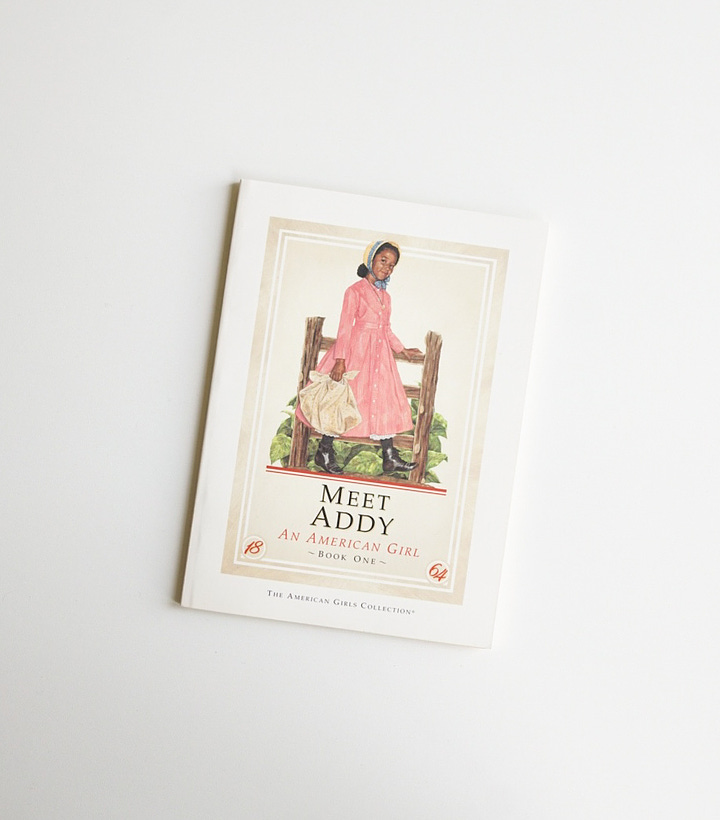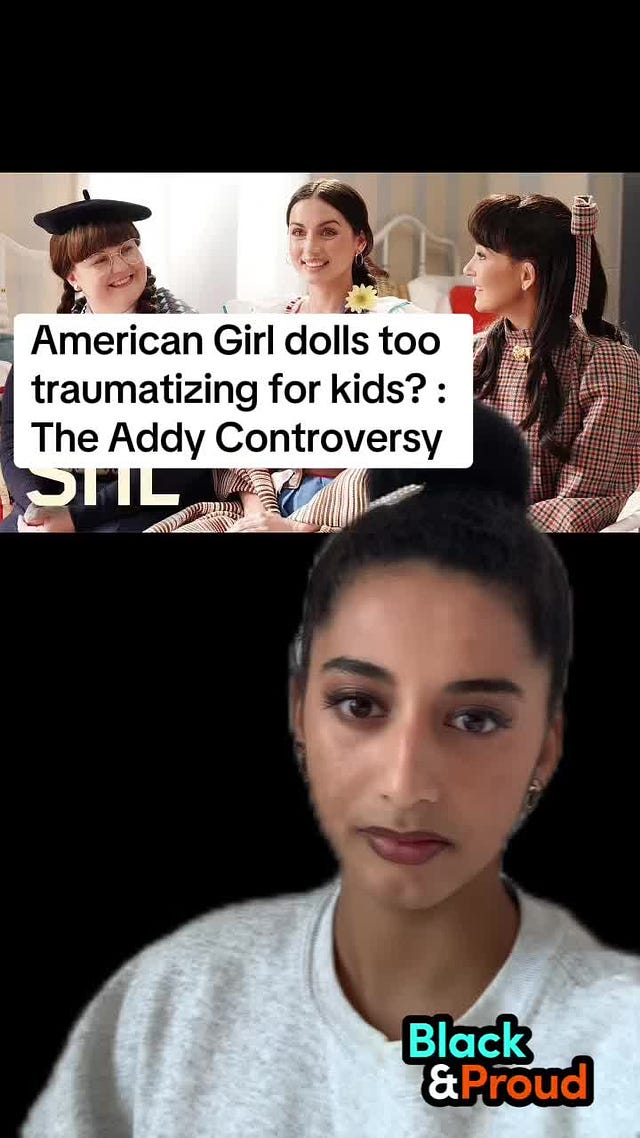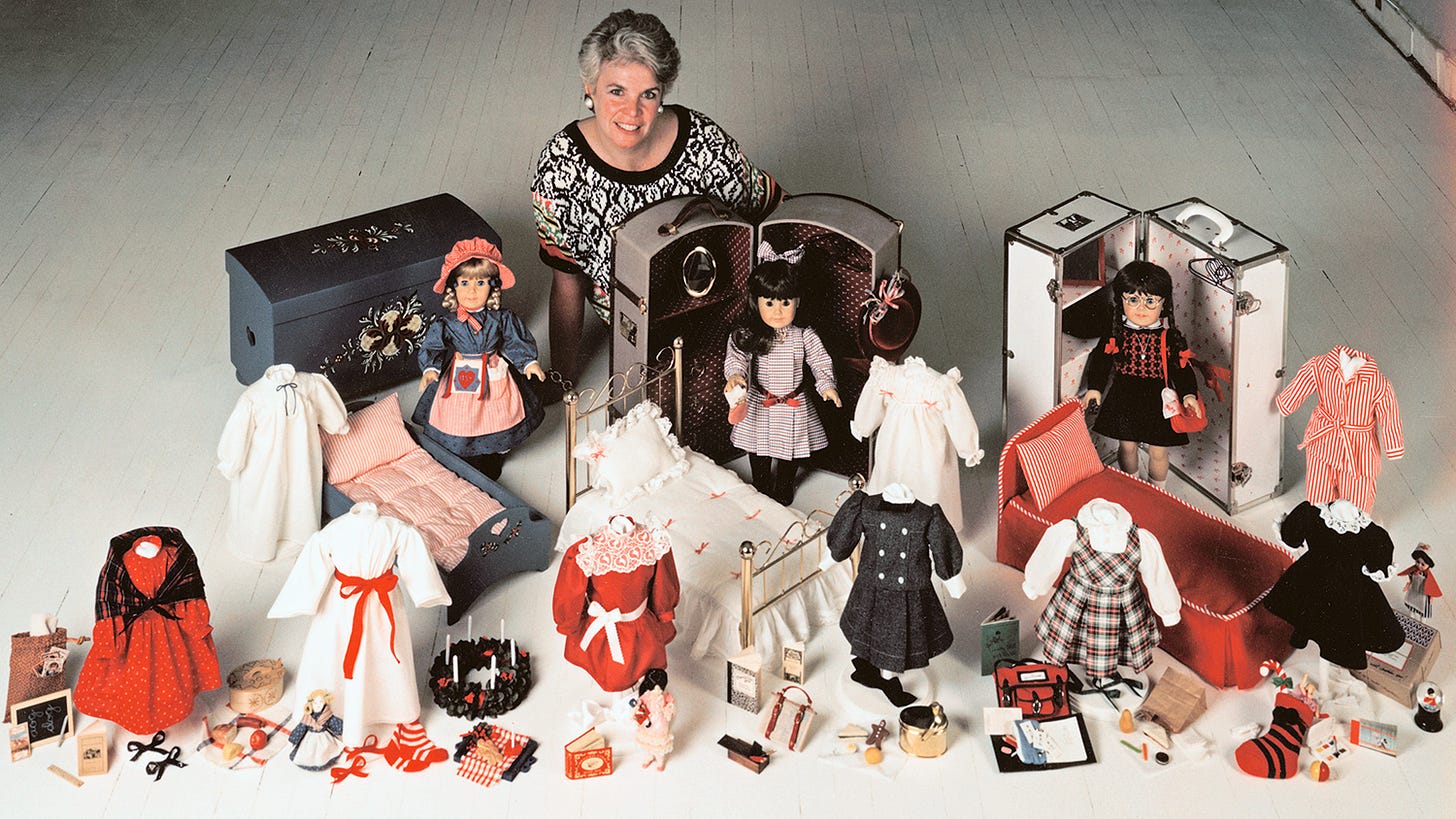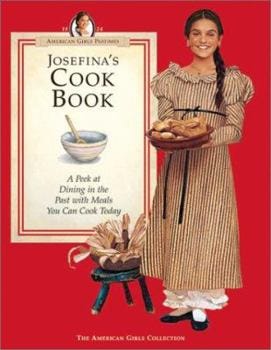There was a long, rectangular-shaped gift under the Christmas tree that year. I knew what I wanted it to be, but I also knew it couldn’t be that. There were more important things my parents could be spending their money on in the 90s than an $86 doll named Addy Walker. But when I peeled back the wrapping paper, there she was, waiting for me in her elegant white box. I knew in that moment that Addy and I were going to be the best of friends. I hugged my mom and dad, then quickly removed Addy from her box so I could hug her too.
Addy was part of the American Girls Collection, a doll line created by Pleasant Rowland in 1986. Pleasant had been disappointed that her nieces only had limited options when it came to high-quality dolls and wanted them to have something that mixed both education and play. Walking down the toy aisle, you either had Barbie, which she felt was too mature, or baby dolls, which skewed too young. Why was playtime for little girls so hyper-focused on reenacting motherhood? Why weren’t there more dolls on the market that reflected the ages of the children who would be playing with them?
Pleasant had asked herself these questions many times, and the idea for the solution finally came to her during a trip to Williamsburg, Virginia. There, history came to life for her—the costumes, the stories, and the props all blending together to bring the historic figures from the pages of her textbooks to life. She loved how her visit was a tangible, tactile experience. What if she could replicate this feeling for little girls through a series of books and dolls that let them learn American history through interactive, imaginative play?
The first three dolls launched in 1986 to a great success. Felicity would be released next, then Addy would be the fifth to be introduced in 1993. As the first black doll of the collection, Pleasant knew she would only have one chance to get it right. She would assemble a formal advisory board of black scholars and historians to advise on Addy’s creation, and tap a very special author named Connie Porter to help bring Addy to life.


While researching for this piece, I sifted through various early articles featuring interviews with Porter around the time of Addy’s release. I never realized she was the same age as I am now—33—when she wrote Addy’s book series. It made me stop and reflect on how this age can be such a beautiful time of discovery and opportunity, especially when I’ve been feeling so stuck lately.
"I wasn't interested at first because I was so busy,” Connie said, but Pleasant persisted. “They sent me information on the company and the project, and I was impressed by their mission to present historical fiction for ages 7 and up. So I decided to take them up on it."
Addy’s story takes place during the end of the Civil War, with her books following her family’s escape to freedom. Quite often, the first time we see ourselves reflected is through playtime. What does it mean for a little black girl to play with a doll representing a young girl escaping slavery? While I can’t speak for everyone, I can share what growing up with Addy meant to me—and what it means to me now, looking back.
As a little girl, I knew I was different from my white friends, but I didn’t quite know how to put it into words. I just had this feeling that a big part of the world thought less of me because my skin was darker. And as I got older I would experience racism and was like “oh that was the feeling my little mind was preparing me for.”
I could tell that everyone wanted to be the people who had the starring roles on TV—the ones with long blonde hair and sparkling blue eyes. Everyone wanted to be them, including me. But I couldn’t be.
My mom would quickly turn that around, teaching me to be confident in my own skin. She showed me that my hair texture was beautiful and that, because it wasn’t bone straight, it could hold many different hairstyles like twists, braids, and curls. She told me my brown skin glowed and was something I should be proud of because of the stories it held. Little by little, I came to understand that I could take center stage without the sparkling blue eyes and that our eyes sparkled too.
The Pleasant Company catalog arrived in the mail in 1996, and I met Addy for the first time. Her soft, huggable body was displayed across two pages in all her striped cinnamon pink dress glory. Her brown skin and matching brown eyes, her textured hair, and her detailed cowry shell necklace, I had never seen a doll so beautiful. Even at a young age, I could tell she was expensive, something to be cherished, a family heirloom. I asked for her but knew I’d never get her. I settled for flipping through the catalog, imagining the items magically appearing before me every time I woke up from my dreams. So you can imagine my excitement when I finally received her that Christmas morning.
When I read Addy’s books, it was one of the first times the concept of slavery became real to me. As a child, I knew our people had experienced it, but I didn’t fully understand what it was. Connie Porter had a way of writing Addy and her family as real people going through very real things, and she refused to skirt around the truth of our history.
“I wanted children to see African American people as part of strong, loving families, caught up in slavery, doing what they had to do to survive,” Connie has said.
Because of this, Pleasant Company faced backlash for creating a doll that dealt with slavery. When asked about the controversy in 1996, Connie responded:
"They are dealing with their own personal baggage," she said of the early critics of the slavery theme. "Children need to know about this material. Or would you rather me lie about history?"

 Tiktok failed to load.
Tiktok failed to load.Enable 3rd party cookies or use another browser
As I sit here typing this, I have Addy sitting on my desk. I think about bringing her to playdates as a child while my other friends toted their Samanthas and Mollys. And I remember feeling confident for one of the first times in my short life. I felt like I belonged. Because my doll, like theirs, was also part of American history. Her story mattered, and therefore mine did too.
Addy Walker taught me how to take up space. The same space my other friends were filling with their hopes and dreams. She taught me to stand there in the middle of it all and demand to be seen.
I have Connie to thank for that sense of belonging. Her writing style had a way of luring me in, making me hang onto her every word. She never dumbed down history for our age group but instead insisted on presenting it in a way that was digestible, interesting, and important. Connie captivated us.
And her books, coupled with Pleasant’s unique vision for play, brought Addy’s story to life for me in a whole new way. There were so many touch points to the brand. If you couldn’t afford the doll and her clothes, maybe you could buy the corresponding paper dolls or the cookbooks. You could check out the books from your local library. There were also doll dress patterns so a parent could sew the clothes if purchasing them wasn’t in the budget. It makes me sad that Mattel has discontinued so many of these access points. I truly hope they work to bring some of these elements back for future kids to experience.
Since Addy’s release, American Girl has introduced three more black historical characters: Cécile Rey, an affluent girl living in 1850s New Orleans; Melody Ellison, an outgoing 9-year-old growing up in the Civil Rights era who loves Motown; and most recently, Claudie Wells, whose adventures take place during the Harlem Renaissance (my favorite!). Unfortunately, American Girl chose to archive Cécile’s entire collection, leaving only three black historical dolls out of the 16 currently available.
I believe Addy made many folks uncomfortable because they saw her as a window into a dark past they wanted to keep buried. Addy not only taught me about my history; she also made me proud of where I came from. If others can’t sit with the hard truth of America’s past, how will we ever create change?
“If you don't look at it, you can't change it. You've got to look at it.”
- James Baldwin
Connie and Pleasant understood that. While the American Girls Collection and Addy Walker were not without flaws, Addy was an American Girl—and that was good enough for me.
Works Cited:
• The World of Addy Walker Directed by Pleasant Company LLC 1995
• Keenan, Dorothy. “History Through a Child’s Eyes.” Buffalo News, December 12, 1993, https://buffalonews.com/news/history-through-a-childs-eyes-author-connie-porters-new-american-girl-makes-the-fight-for/article_dc7439d4-8fc1-5dc7-b456-75f86d9e8d2d.html
•Bennett, Brit. “Addy Walker, American Girl”. The Paris Review, May 28, 2015,
https://www.theparisreview.org/blog/2015/05/28/addy-walker-american-girl/











Share this post